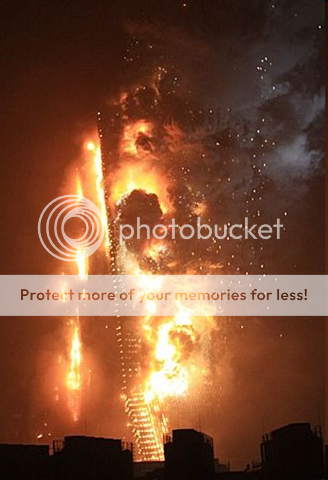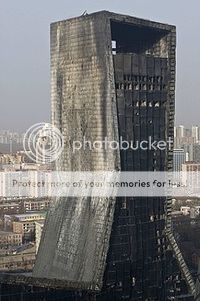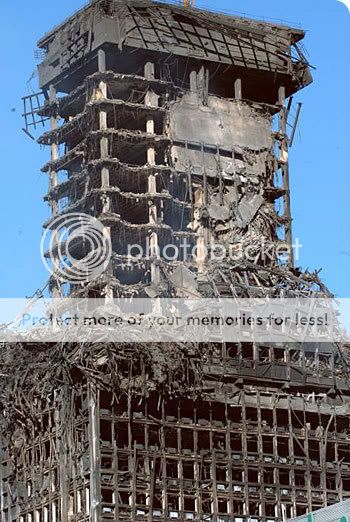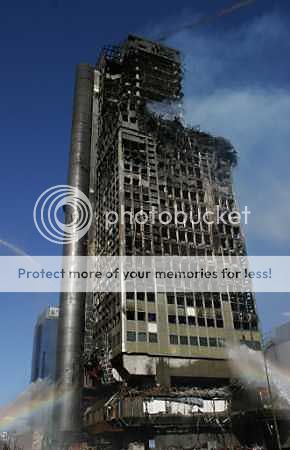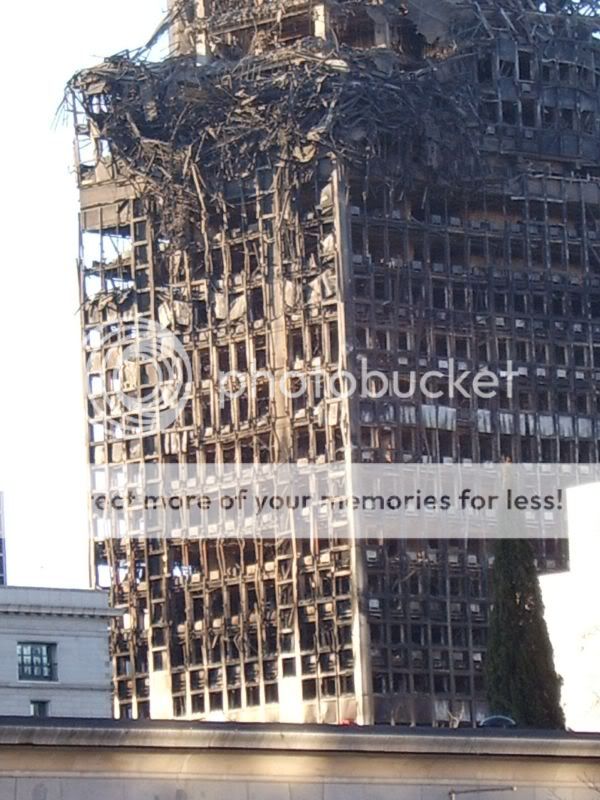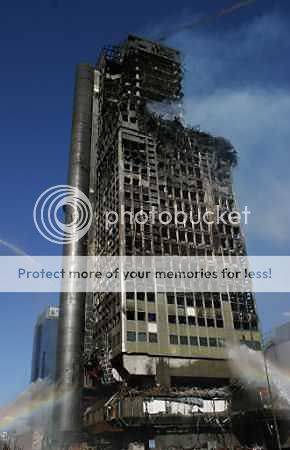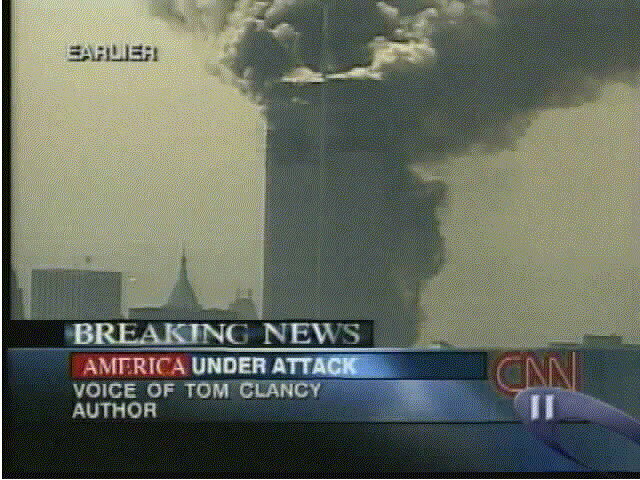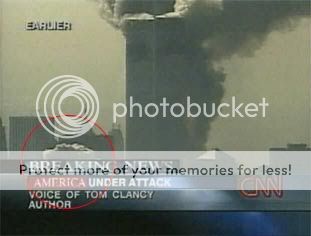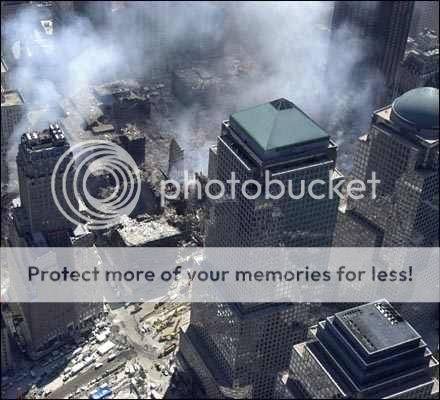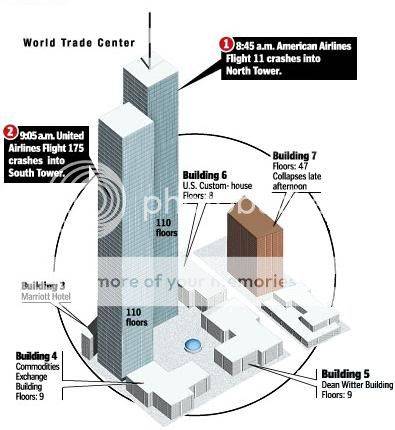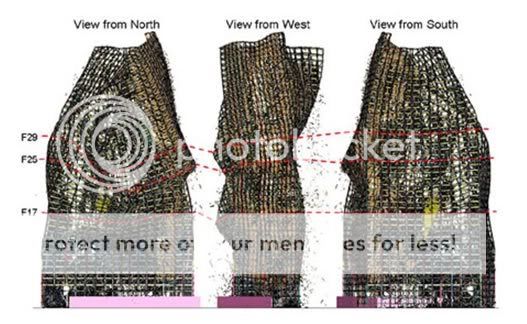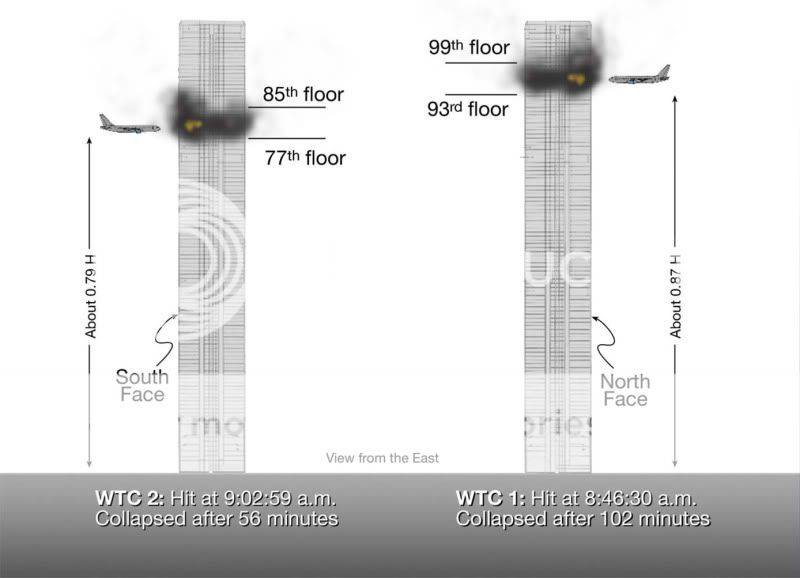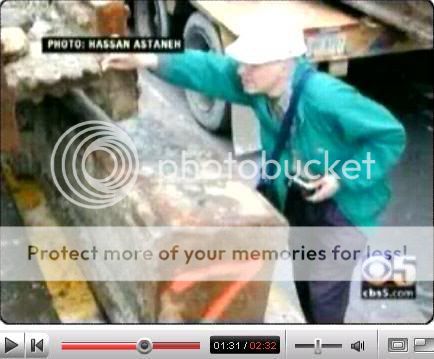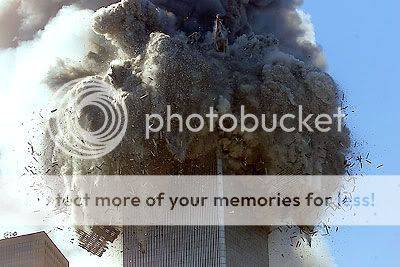In NIST's computer, steel can do just about anything. We saw that in the report for the towers, where we were told that similar computerized office fires made floors sag, columns shorten, and large quantities of steel melt soften weaken. This time, we have what NIST calls a "new phenomenon" for structural steel, called thermal expansion.
"Fire-induced thermal expansion of the floor system surrounding Column 79 led to the collapse of Floor 13, which triggered a cascade of floor failures. In this case, the floor beams on the east side of the building expanded enough that they pushed the girder connecting Columns 79 and 44 to the west on the 13th floor."
"The displaced girder and other local fire-induced damage caused Floor 13 to collapse, beginning a cascade of floor failures down to the 5th floor This left Column 79 with insufficient lateral support in the east-west direction. The column buckled eastward, becoming the initial local failure for collapse initiation." NCSTAR 1-A, p 19-20
With this summary statement, NIST begins its explanation with a sleight of hand. The "initial local failure" is not a column buckling according to this new story, but is the displacement of a girder by means of the thermal expansion of up to five floor beams. It is there that we must begin our analysis of NIST's new story, and if that is not realistic, then none of the remaining explanation for WTC 7 is realistic.
We should begin with a fact described in one of NIST's earlier reports on WTC 7.
"Most of the beams and girders [in WTC 7] were made composite with the slabs through the use of shear studs." NCSTAR 1-1, p 14
NIST now contradicts this earlier finding, in order to support the new story.
"In WTC 7 no studs were installed on the girders." NCSTAR 1-9, p346
For the thermal expansion story, this presence of shear studs holding the concrete floor to the beams and girders is important. The studs were 0.75 in x 5 in long, and were positioned every 1 to 2 ft along the beam or girder, according to NCSTAR 1-1. There were 28 of these studs for each of the five beams that supposedly expanded. NIST deceptively played down all those shear studs in its recent presentation, where a simple diagram falsely suggested there were only three studs for each beam.
For the allegedly displaced girder, according to NIST's first report there would have been a similar number of shear studs, placed at intervals of 1 to 2 feet, for a total of at least 22 studs. But NIST's new report removes all of these in order to make it easier for the girder to be pushed out. Some of NIST's other diagrams indicate that the girder was fastened to column 79 with only two seat bolts. There were, in fact, two seat bolts and two clip bolts for each girder/column connection. Additionally, NIST unconvincingly tells us that it "found no evidence that the girders or beams in WTC 7 were welded to the seats" (NCSTAR 1-9, p 348). Of course, by now we know what NIST means when it says it "found no evidence."
This is what the basic premise of NIST's new story looks like, if we assume there was no seat welding, and all the shear studs have been removed, or have broken away from, the beams and the girder.
As we can see, it appears NIST is telling us that the loose beams (only one shown) deflected the loose girder a distance of several feet. Even if we believe that WTC 7 was built in such a shoddy manner, is this hypothesis realistic?
First, note that thermal expansion is not a new phenomenon, and structural steel was not just invented for use at the WTC. Such effects have been a possibility in all of the thousands of other situations in which structural steel was heated throughout history. So what enormous new difference did thermal expansion make for WTC 7?
The floor beams that NIST is speaking of, that supposedly pushed the girder between column 79 and column 44 completely out of place, were each about 52 feet, or 15.8 meters, in length. The equation for linear thermal expansion is as follows:
ΔL = α Lo ΔT
That is, the increase in length of the object considered is a function of the product of the coefficient of linear expansion (α , the original length, and the change in temperature. The coefficient of linear expansion for steel is about 0.000012 m/m/°C.
, the original length, and the change in temperature. The coefficient of linear expansion for steel is about 0.000012 m/m/°C.
Using the equation above, the beams could have expanded 0.019 m for every 100°C increase in temperature. Remember also that any thermal linear expansion would have been acting on the external columns of WTC 7's east wall as well, because thermal expansion does not affect just one end of a beam. Whatever distance the beams pushed NIST's critical girder, the same distance in bowing out of the east wall of WTC 7 would have had to occur, unless WTC 7 was a very unstable structure to begin with. Therefore, half of the total expansion length (0.01 m) would have affected NIST's critical girder for every 100°C increase in temperature.
For NIST's new story, those floor beams would have had to not only expand linearly, but also break 28 high-strength shear studs, 2 seat bolts, 2 clip bolts (and seat welds), and then cause the buckling of a gigantic girder (which also had 22 shear studs) before the beams themselves buckled or even weakened.
This is quite the opposite of what NIST says happened in the towers, where the official story is that the floors sagged dramatically. In WTC7, NIST now says the floors did not sag or weaken a bit, but remained fiercely rigid as high-temperature linear expansion caused them to wreak havoc on the surrounding structure.
Highly exaggerated temperatures leave beams rigid
To accomplish the linear expansion, the beams first had to get very hot. NIST says that its computer models suggest that "some sections" of these beams reached 600°C.
"Due to the effectiveness of the SFRM, the highest column temperatures in WTC 7 only reached an estimated 300°C (570°F), and only on the east side of the building did the floor beams reach or exceed about 600°C." NCSTAR 1A, p 19
"The temperatures of some sections of the beams supporting Floors 8, 12, 13, and 14 exceeded 600°C." NCSTAR 1A, p 48
These extremely high steel temperatures would most certainly have resulted in the weakening of the beams, once the shear studs had been lost, allowing the thermal expansion to be relieved through downward sagging. This fact is supported by the experimental data produced by the Cardington tests, described in NCSTAR 1-9 (section 8.4.3), where much shorter floor beam spans experienced significant sagging. Therefore, this rigid beam linear expansion hypothesis is not realistic.
In any case, although NIST does not state it clearly in the new report, a 575°C increase in temperature would have caused the girder end of the beams to experience a maximum of 2.2 inches of deflection. And if it were only a "section," for example only a third of a beam length, then the increase from thermal expansion would be correspondingly smaller (or 0.7 inches). This makes NIST's story of all those bolts and studs breaking in unison, and that critical girder buckling, quite unbelievable.
But how did the beams reach 600°C in the first place? In the real world, this would have required very hot fires for a very long time. In NIST's computer, of course, this was not a problem. As with the report for the towers, these cyber-space investigators only needed to fudge a few numbers, like the thermal conductivity of the materials involved. Structural steel has a thermal conductivity of 46 W/m/K, which means that any heat applied is easily wicked away. But if that value were set to zero, or near zero, any heat applied would allow the temperature to rise dramatically at the point of application.
"The steel was assumed in the FDS model to be thermally-thin, thus, no thermal conductivity was used." NCSTAR 1-5F, p 20
"The interior walls [including insulated steel columns] were assumed to have the properties of gypsum board [0.5 W/m/K]." NCSTAR 1-5F, p 52
"Although the floor slab actually consisted of a metal deck topped with a concrete slab the thermal properties of the entire floor slab were assumed to be that of concrete [1.0 W/m/K]." NCSTAR 1-5F, p 52
Fudging the thermal conductivity values, and extrapolating the localized computer results across vast sections of the building, appears to be how NIST scientists convinced themselves that they could promote the high steel temperatures.
But also note that raising those five floor beams to a temperature of 600°C would require an enormous amount of energy, far more than was available from the burning of the office furnishings underneath the floor beams. Of course, NIST has not had any trouble selling such leaps of imagination before, as its media sponsors don't ask detailed questions and NIST does not discuss its reports with independent investigators.
Brief office fires in an environment designed for fire resistance
Further problems for NIST's new story result from admissions NIST has made about the state of the fires in the building, and the design of the structure. NIST admits that the fires in WTC 7 were typical office fires, and that the fires could not move from floor to floor.
"Their growth and spread were consistent with ordinary building contents fires." NCSTAR 1A, p xxxii
"There was no evidence of floor-to-floor fire spread until perhaps just before the WTC 7 collapse. Thus, the fire-rated floors were successful as fire penetration barriers." NCSTAR 1A, p 55
NIST also admits that the building was designed to comply with New York City Building Code, requiring fire resistance of 3 hours for columns and 2 hours for floors.
"The instructions to the bidders for the WTC 7 job were to bid on a 3 h rating for the columns and a 2 h rating for the fluted steel decking and floor support steel, which corresponded to the more stringent fire resistance requirements for Type 1B (unsprinklered) construction." NCSTAR 1A, p 7
"Private inspectors found that the applied SFRM thicknesses were consistent with these values." NCSTAR 1A, p 7 (also see NCSTAR 1-9, table 8-1, p 340)
Add to these facts that NIST admitted in their December 2007 advisory committee meeting that the fuel load could only support 20 minutes of fire in any given location.
"Question: fire moved every 20 minutes; essentially it started and stopped every 20 minutes, so if you do not have fuel in WTC 7, how could fires burn for as long as they had and taken out this major structure that had good fireproofing?"
"Answer (Sunder): The fires moved from location to location, meaning that at any given location the combustibles needed about 20 minutes to be consumed. While the combustibles at a location were being consumed, the fire front would be progressing to adjacent combustibles."23
For floors 11 and 12, NIST increased this estimated fuel load from 4 lb/ft2 to 6.4 lb/ft2, presumably giving a new maximum fire time of 32 minutes. Even so, how then did NIST come up with fire times of 3.5 to 4 hours?
"However, it appeared likely the critical damage state occurred between 3.5 h and 4 h." NCSTAR 1A, p 32
What could possibly have been burning, under those beams, for another three hours?
Without answers to these questions, we must assume that NIST is now suggesting specific corporate culpability for the failure of WTC 7.
Basically, NIST is saying Underwriters Laboratories is to blame
To sum up, steel components that were certified to withstand hours of fire failed in typical office fires lasting a maximum of 32 minutes in any given location. That means that there must have been negligence, or extremely poor performance, on the part of those who ensured the fire resistance of the structural components.
With the report on the towers, NIST pretended that it was a mystery as to who tested the steel components for fire resistance. But, in fact, it wasn't actually that much of a mystery unless you asked UL while the whole country was watching.24 But for WTC 7, NIST comes right out and says that UL was the firm that provided the fire resistance information for the building.
"According to the Underwriters Laboratories (UL) Fire Resistance Directory (1983), these ratings required a thickness of 7/8 in. of Monokote MK-5 to be applied to the heavy columns, 1 7/8 in. to be applied to the lighter columns, ½ in. to be applied to the beams, and 3/8 in. to be applied to the bottom of the metal deck." NCSTAR 1A, p 7
That's one good reason why UL is not listed as being part of the WTC 7 investigation. Having the company that was responsible for establishing the fire resistance of the building participate in the politically motivated investigation into how the building failed from fire might just be a conflict of interest.
The problem NIST and UL have now is that confirming UL's involvement in the WTC 7 design, when the official story is centered only on failure by fire, could lead to greater problems for UL. It is clear that UL must now answer for how the structural components of WTC 7 failed catastrophically, in typical office fires, when UL's Fire Resistance Directory reported that these components would resist fire damage for much longer.
The final WTC 7 story and how it was predicted
After years of talking about diesel fuel fires and damage from the towers being the causes of the near free-fall collapse of WTC 7, and then acting as if they just couldn't get a handle on it, NIST now has a new "obvious" story. The new story is based on a "new phenomenon" of thermal expansion whereby fully insulated steel beams are exposed to temperatures of 600°C in only 32 minutes. Believe it or not, NIST actually says this happened in only a few seconds (NCSTAR 1-9, table 8-2, p 353).
This extreme temperature, which did not weaken the beams at all, as would have happened in WTC 1 or WTC 2, broke all the shear studs, seat bolts and clip bolts on all the beams of the east wall of WTC 7. The beams then expanded linearly, pushing the girder between column 79 and column 44 by a maximum of 2.2 inches, causing that critical girder to buckle and fall away from columns 79 and 44.
We have seen that this "initial local failure" is not realistic. This is because the fire times could not possibly have caused the high steel temperatures cited, the steel would not have remained rigid if those temperatures had been reached, and the very slight thermal expansion would not have been great enough to cause the extensive girder damage imagined by NIST.
From that tenuous position, we are led to believe that the one fallen girder caused one column to buckle and that meant the total destruction of this 47-story building in a matter of seconds.
But who could have predicted all of this? NIST admits that this is a rare phenomenon that it had to work hard to prove.
"Failure of a floor beam in fire is a rare event, and, indeed, there have been many building fires that have not resulted in even local failures of the floor system. The challenge was to determine if a fire-induced floor system failure could occur in WTC 7 under an ordinary building contents fire." NCSTAR 1-9, p 330
What geniuses knew that this new phenomenon of the thermal expansion of several floor beams in unison would cause this one hair-trigger girder to bring the entire building down several hours before it actually occurred?
Many people did, including at least 60 fire department employees, more than 25 medical and emergency workers, and both CNN and the BBC.
And if you believe all that
NIST topped off this most ridiculous of explanations with a truly bizarre consideration of a "hypothetical blast event."
First, NIST asks us to assume that it wasn't a planned demolition. We are led to believe that no one would have placed explosive charges around the entire building to cause what appears to everyone who sees it as a completely symmetrical and purely vertical near free-fall implosion.
On the contrary, NIST says that if WTC 7 was to have been a demolition, it would have to begin with an assumption that most of their new story is correct. That is, anybody wanting to bring the building down in a demolition event would have obviously placed one gigantic bomb under that one all important column column 79.
Therefore, let's play along with this dishonest pretense and see what NIST says that would do.
A "Blast from the smallest charge capable of failing the critical column would have resulted in a sound level of 130 dB to 140 dB at a distance of at least half a mile. There were no witness reports of such a loud noise, nor was such a noise heard on the audio tracks of video recordings of the WTC 7 collapse." NCSTAR 1-A, p xxxii
Essentially, NIST is saying that WTC 7 was not a demolition because a big boom would make a big sound. That, ladies and gentlemen, is the culmination of seven years of Bush Science.
No failure of imagination here
The 9/11 Commission told us that the attacks on September 11th succeeded ultimately because of a "failure of imagination." NIST will never be accused of that kind of failure, as its new WTC 7 report is nothing but imaginary tripe.
This new story contradicts the previous major claims by NIST, ignores the most important of the existing evidence, produces no scientific test results to support itself, and is so obviously false on its face that not even a fictional character from another planet would believe it. Fires that could only last 20 to 30 minutes lasted 4 hours (what was burning?). Imaginary temperatures that, according to NIST would have easily weakened the same steel in the towers, left beams fully rigid so that they could push one girder a full 2.2 inches, somehow breaking numerous bolts and studs in unison, as well as buckling the girder, before the beams themselves were affected in any way. Suddenly this one girder failure caused numerous floors to collapse, one hair-trigger "switch" column to buckle, and the whole building to fall in a total of 8 seconds.
NIST tells us that most of these unprecedented, illogical and thoroughly fantastic events were happening within the box of WTC 7 itself, before we saw anything.
The NIST WTC 7 Report:: Bush Science reaches its peak
Some of you people may me mesmerized by planes and fireballs, but there are others who have managed to go beyond the theatrics to obtain real facts about the ludicrous and false NIST report and the insane allegations within them.
"Fire-induced thermal expansion of the floor system surrounding Column 79 led to the collapse of Floor 13, which triggered a cascade of floor failures. In this case, the floor beams on the east side of the building expanded enough that they pushed the girder connecting Columns 79 and 44 to the west on the 13th floor."
"The displaced girder and other local fire-induced damage caused Floor 13 to collapse, beginning a cascade of floor failures down to the 5th floor This left Column 79 with insufficient lateral support in the east-west direction. The column buckled eastward, becoming the initial local failure for collapse initiation." NCSTAR 1-A, p 19-20
With this summary statement, NIST begins its explanation with a sleight of hand. The "initial local failure" is not a column buckling according to this new story, but is the displacement of a girder by means of the thermal expansion of up to five floor beams. It is there that we must begin our analysis of NIST's new story, and if that is not realistic, then none of the remaining explanation for WTC 7 is realistic.
We should begin with a fact described in one of NIST's earlier reports on WTC 7.
"Most of the beams and girders [in WTC 7] were made composite with the slabs through the use of shear studs." NCSTAR 1-1, p 14
NIST now contradicts this earlier finding, in order to support the new story.
"In WTC 7 no studs were installed on the girders." NCSTAR 1-9, p346
For the thermal expansion story, this presence of shear studs holding the concrete floor to the beams and girders is important. The studs were 0.75 in x 5 in long, and were positioned every 1 to 2 ft along the beam or girder, according to NCSTAR 1-1. There were 28 of these studs for each of the five beams that supposedly expanded. NIST deceptively played down all those shear studs in its recent presentation, where a simple diagram falsely suggested there were only three studs for each beam.
For the allegedly displaced girder, according to NIST's first report there would have been a similar number of shear studs, placed at intervals of 1 to 2 feet, for a total of at least 22 studs. But NIST's new report removes all of these in order to make it easier for the girder to be pushed out. Some of NIST's other diagrams indicate that the girder was fastened to column 79 with only two seat bolts. There were, in fact, two seat bolts and two clip bolts for each girder/column connection. Additionally, NIST unconvincingly tells us that it "found no evidence that the girders or beams in WTC 7 were welded to the seats" (NCSTAR 1-9, p 348). Of course, by now we know what NIST means when it says it "found no evidence."
This is what the basic premise of NIST's new story looks like, if we assume there was no seat welding, and all the shear studs have been removed, or have broken away from, the beams and the girder.
As we can see, it appears NIST is telling us that the loose beams (only one shown) deflected the loose girder a distance of several feet. Even if we believe that WTC 7 was built in such a shoddy manner, is this hypothesis realistic?
First, note that thermal expansion is not a new phenomenon, and structural steel was not just invented for use at the WTC. Such effects have been a possibility in all of the thousands of other situations in which structural steel was heated throughout history. So what enormous new difference did thermal expansion make for WTC 7?
The floor beams that NIST is speaking of, that supposedly pushed the girder between column 79 and column 44 completely out of place, were each about 52 feet, or 15.8 meters, in length. The equation for linear thermal expansion is as follows:
ΔL = α Lo ΔT
That is, the increase in length of the object considered is a function of the product of the coefficient of linear expansion (α
Using the equation above, the beams could have expanded 0.019 m for every 100°C increase in temperature. Remember also that any thermal linear expansion would have been acting on the external columns of WTC 7's east wall as well, because thermal expansion does not affect just one end of a beam. Whatever distance the beams pushed NIST's critical girder, the same distance in bowing out of the east wall of WTC 7 would have had to occur, unless WTC 7 was a very unstable structure to begin with. Therefore, half of the total expansion length (0.01 m) would have affected NIST's critical girder for every 100°C increase in temperature.
For NIST's new story, those floor beams would have had to not only expand linearly, but also break 28 high-strength shear studs, 2 seat bolts, 2 clip bolts (and seat welds), and then cause the buckling of a gigantic girder (which also had 22 shear studs) before the beams themselves buckled or even weakened.
This is quite the opposite of what NIST says happened in the towers, where the official story is that the floors sagged dramatically. In WTC7, NIST now says the floors did not sag or weaken a bit, but remained fiercely rigid as high-temperature linear expansion caused them to wreak havoc on the surrounding structure.
Highly exaggerated temperatures leave beams rigid
To accomplish the linear expansion, the beams first had to get very hot. NIST says that its computer models suggest that "some sections" of these beams reached 600°C.
"Due to the effectiveness of the SFRM, the highest column temperatures in WTC 7 only reached an estimated 300°C (570°F), and only on the east side of the building did the floor beams reach or exceed about 600°C." NCSTAR 1A, p 19
"The temperatures of some sections of the beams supporting Floors 8, 12, 13, and 14 exceeded 600°C." NCSTAR 1A, p 48
These extremely high steel temperatures would most certainly have resulted in the weakening of the beams, once the shear studs had been lost, allowing the thermal expansion to be relieved through downward sagging. This fact is supported by the experimental data produced by the Cardington tests, described in NCSTAR 1-9 (section 8.4.3), where much shorter floor beam spans experienced significant sagging. Therefore, this rigid beam linear expansion hypothesis is not realistic.
In any case, although NIST does not state it clearly in the new report, a 575°C increase in temperature would have caused the girder end of the beams to experience a maximum of 2.2 inches of deflection. And if it were only a "section," for example only a third of a beam length, then the increase from thermal expansion would be correspondingly smaller (or 0.7 inches). This makes NIST's story of all those bolts and studs breaking in unison, and that critical girder buckling, quite unbelievable.
But how did the beams reach 600°C in the first place? In the real world, this would have required very hot fires for a very long time. In NIST's computer, of course, this was not a problem. As with the report for the towers, these cyber-space investigators only needed to fudge a few numbers, like the thermal conductivity of the materials involved. Structural steel has a thermal conductivity of 46 W/m/K, which means that any heat applied is easily wicked away. But if that value were set to zero, or near zero, any heat applied would allow the temperature to rise dramatically at the point of application.
"The steel was assumed in the FDS model to be thermally-thin, thus, no thermal conductivity was used." NCSTAR 1-5F, p 20
"The interior walls [including insulated steel columns] were assumed to have the properties of gypsum board [0.5 W/m/K]." NCSTAR 1-5F, p 52
"Although the floor slab actually consisted of a metal deck topped with a concrete slab the thermal properties of the entire floor slab were assumed to be that of concrete [1.0 W/m/K]." NCSTAR 1-5F, p 52
Fudging the thermal conductivity values, and extrapolating the localized computer results across vast sections of the building, appears to be how NIST scientists convinced themselves that they could promote the high steel temperatures.
But also note that raising those five floor beams to a temperature of 600°C would require an enormous amount of energy, far more than was available from the burning of the office furnishings underneath the floor beams. Of course, NIST has not had any trouble selling such leaps of imagination before, as its media sponsors don't ask detailed questions and NIST does not discuss its reports with independent investigators.
Brief office fires in an environment designed for fire resistance
Further problems for NIST's new story result from admissions NIST has made about the state of the fires in the building, and the design of the structure. NIST admits that the fires in WTC 7 were typical office fires, and that the fires could not move from floor to floor.
"Their growth and spread were consistent with ordinary building contents fires." NCSTAR 1A, p xxxii
"There was no evidence of floor-to-floor fire spread until perhaps just before the WTC 7 collapse. Thus, the fire-rated floors were successful as fire penetration barriers." NCSTAR 1A, p 55
NIST also admits that the building was designed to comply with New York City Building Code, requiring fire resistance of 3 hours for columns and 2 hours for floors.
"The instructions to the bidders for the WTC 7 job were to bid on a 3 h rating for the columns and a 2 h rating for the fluted steel decking and floor support steel, which corresponded to the more stringent fire resistance requirements for Type 1B (unsprinklered) construction." NCSTAR 1A, p 7
"Private inspectors found that the applied SFRM thicknesses were consistent with these values." NCSTAR 1A, p 7 (also see NCSTAR 1-9, table 8-1, p 340)
Add to these facts that NIST admitted in their December 2007 advisory committee meeting that the fuel load could only support 20 minutes of fire in any given location.
"Question: fire moved every 20 minutes; essentially it started and stopped every 20 minutes, so if you do not have fuel in WTC 7, how could fires burn for as long as they had and taken out this major structure that had good fireproofing?"
"Answer (Sunder): The fires moved from location to location, meaning that at any given location the combustibles needed about 20 minutes to be consumed. While the combustibles at a location were being consumed, the fire front would be progressing to adjacent combustibles."23
For floors 11 and 12, NIST increased this estimated fuel load from 4 lb/ft2 to 6.4 lb/ft2, presumably giving a new maximum fire time of 32 minutes. Even so, how then did NIST come up with fire times of 3.5 to 4 hours?
"However, it appeared likely the critical damage state occurred between 3.5 h and 4 h." NCSTAR 1A, p 32
What could possibly have been burning, under those beams, for another three hours?
Without answers to these questions, we must assume that NIST is now suggesting specific corporate culpability for the failure of WTC 7.
Basically, NIST is saying Underwriters Laboratories is to blame
To sum up, steel components that were certified to withstand hours of fire failed in typical office fires lasting a maximum of 32 minutes in any given location. That means that there must have been negligence, or extremely poor performance, on the part of those who ensured the fire resistance of the structural components.
With the report on the towers, NIST pretended that it was a mystery as to who tested the steel components for fire resistance. But, in fact, it wasn't actually that much of a mystery unless you asked UL while the whole country was watching.24 But for WTC 7, NIST comes right out and says that UL was the firm that provided the fire resistance information for the building.
"According to the Underwriters Laboratories (UL) Fire Resistance Directory (1983), these ratings required a thickness of 7/8 in. of Monokote MK-5 to be applied to the heavy columns, 1 7/8 in. to be applied to the lighter columns, ½ in. to be applied to the beams, and 3/8 in. to be applied to the bottom of the metal deck." NCSTAR 1A, p 7
That's one good reason why UL is not listed as being part of the WTC 7 investigation. Having the company that was responsible for establishing the fire resistance of the building participate in the politically motivated investigation into how the building failed from fire might just be a conflict of interest.
The problem NIST and UL have now is that confirming UL's involvement in the WTC 7 design, when the official story is centered only on failure by fire, could lead to greater problems for UL. It is clear that UL must now answer for how the structural components of WTC 7 failed catastrophically, in typical office fires, when UL's Fire Resistance Directory reported that these components would resist fire damage for much longer.
The final WTC 7 story and how it was predicted
After years of talking about diesel fuel fires and damage from the towers being the causes of the near free-fall collapse of WTC 7, and then acting as if they just couldn't get a handle on it, NIST now has a new "obvious" story. The new story is based on a "new phenomenon" of thermal expansion whereby fully insulated steel beams are exposed to temperatures of 600°C in only 32 minutes. Believe it or not, NIST actually says this happened in only a few seconds (NCSTAR 1-9, table 8-2, p 353).
This extreme temperature, which did not weaken the beams at all, as would have happened in WTC 1 or WTC 2, broke all the shear studs, seat bolts and clip bolts on all the beams of the east wall of WTC 7. The beams then expanded linearly, pushing the girder between column 79 and column 44 by a maximum of 2.2 inches, causing that critical girder to buckle and fall away from columns 79 and 44.
We have seen that this "initial local failure" is not realistic. This is because the fire times could not possibly have caused the high steel temperatures cited, the steel would not have remained rigid if those temperatures had been reached, and the very slight thermal expansion would not have been great enough to cause the extensive girder damage imagined by NIST.
From that tenuous position, we are led to believe that the one fallen girder caused one column to buckle and that meant the total destruction of this 47-story building in a matter of seconds.
But who could have predicted all of this? NIST admits that this is a rare phenomenon that it had to work hard to prove.
"Failure of a floor beam in fire is a rare event, and, indeed, there have been many building fires that have not resulted in even local failures of the floor system. The challenge was to determine if a fire-induced floor system failure could occur in WTC 7 under an ordinary building contents fire." NCSTAR 1-9, p 330
What geniuses knew that this new phenomenon of the thermal expansion of several floor beams in unison would cause this one hair-trigger girder to bring the entire building down several hours before it actually occurred?
Many people did, including at least 60 fire department employees, more than 25 medical and emergency workers, and both CNN and the BBC.
And if you believe all that
NIST topped off this most ridiculous of explanations with a truly bizarre consideration of a "hypothetical blast event."
First, NIST asks us to assume that it wasn't a planned demolition. We are led to believe that no one would have placed explosive charges around the entire building to cause what appears to everyone who sees it as a completely symmetrical and purely vertical near free-fall implosion.
On the contrary, NIST says that if WTC 7 was to have been a demolition, it would have to begin with an assumption that most of their new story is correct. That is, anybody wanting to bring the building down in a demolition event would have obviously placed one gigantic bomb under that one all important column column 79.
Therefore, let's play along with this dishonest pretense and see what NIST says that would do.
A "Blast from the smallest charge capable of failing the critical column would have resulted in a sound level of 130 dB to 140 dB at a distance of at least half a mile. There were no witness reports of such a loud noise, nor was such a noise heard on the audio tracks of video recordings of the WTC 7 collapse." NCSTAR 1-A, p xxxii
Essentially, NIST is saying that WTC 7 was not a demolition because a big boom would make a big sound. That, ladies and gentlemen, is the culmination of seven years of Bush Science.
No failure of imagination here
The 9/11 Commission told us that the attacks on September 11th succeeded ultimately because of a "failure of imagination." NIST will never be accused of that kind of failure, as its new WTC 7 report is nothing but imaginary tripe.
This new story contradicts the previous major claims by NIST, ignores the most important of the existing evidence, produces no scientific test results to support itself, and is so obviously false on its face that not even a fictional character from another planet would believe it. Fires that could only last 20 to 30 minutes lasted 4 hours (what was burning?). Imaginary temperatures that, according to NIST would have easily weakened the same steel in the towers, left beams fully rigid so that they could push one girder a full 2.2 inches, somehow breaking numerous bolts and studs in unison, as well as buckling the girder, before the beams themselves were affected in any way. Suddenly this one girder failure caused numerous floors to collapse, one hair-trigger "switch" column to buckle, and the whole building to fall in a total of 8 seconds.
NIST tells us that most of these unprecedented, illogical and thoroughly fantastic events were happening within the box of WTC 7 itself, before we saw anything.
The NIST WTC 7 Report:: Bush Science reaches its peak
Some of you people may me mesmerized by planes and fireballs, but there are others who have managed to go beyond the theatrics to obtain real facts about the ludicrous and false NIST report and the insane allegations within them.

